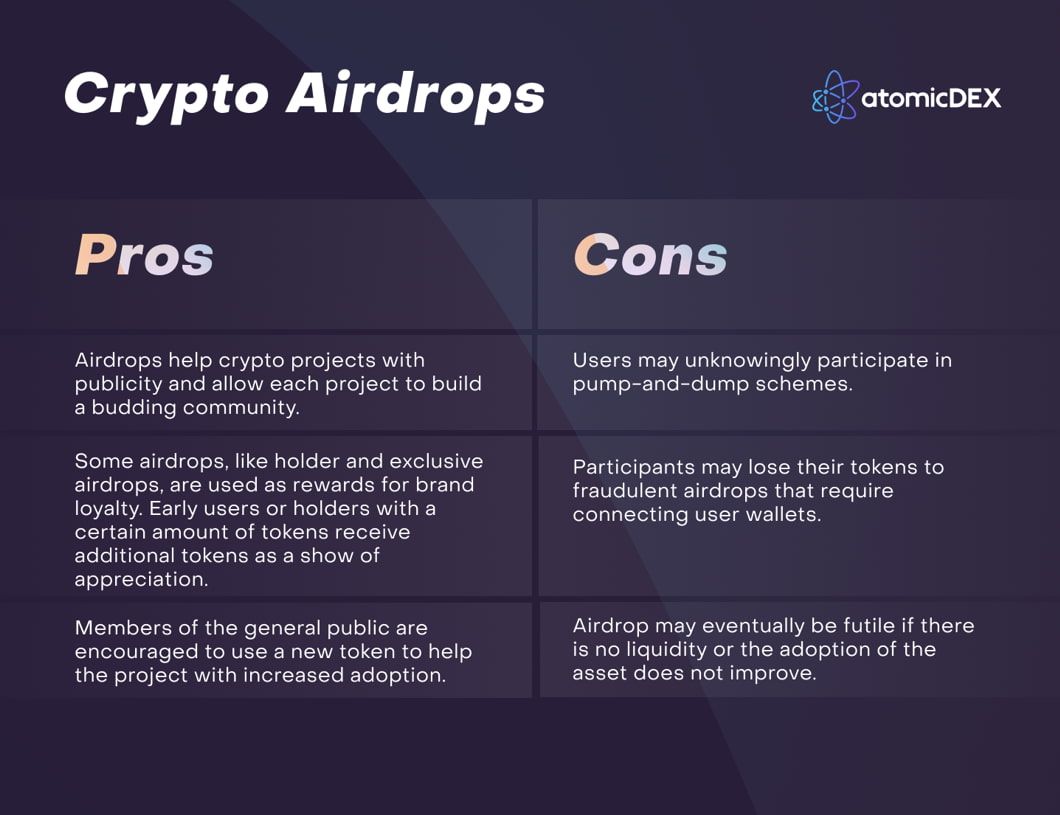
Table of contents
- What Are Crypto Airdrops?
- How Do Crypto Airdrops Work?
- Why Do Crypto Projects Launch Airdrops?
- Types Of Cryptocurrency Airdrops
- How Do You Find Crypto Airdrops?
- Difference Between Crypto Airdrops and Initial Coin Offerings (ICO)
- Are Cryptocurrency Airdrops Safe?
- Pros And Cons Of Cryptocurrency Airdrops
- Participating in Crypto Airdrops
- Hold and Trade Crypto On AtomicDEX
Table of contents
- What Are Crypto Airdrops?
- How Do Crypto Airdrops Work?
- Why Do Crypto Projects Launch Airdrops?
- Types Of Cryptocurrency Airdrops
- How Do You Find Crypto Airdrops?
- Difference Between Crypto Airdrops and Initial Coin Offerings (ICO)
- Are Cryptocurrency Airdrops Safe?
- Pros And Cons Of Cryptocurrency Airdrops
- Participating in Crypto Airdrops
- Hold and Trade Crypto On AtomicDEX
Crypto projects use different methods to achieve specific goals. As with traditional companies, crypto projects put a lot of effort into public relations and advertising, targeted at maximizing their entrance into the market. One major strategy many crypto projects use is the airdrop.
What Are Crypto Airdrops?
A crypto airdrop is a marketing or go-to-market strategy used by a cryptocurrency project to create awareness for themselves and their product(s). These projects can also use crypto airdrops to reward loyal members of their community. An airdrop sends a specified amount of a new asset to these members either for free or in exchange for small promotional acts of service. These acts may include completing an online registration, posting a tweet with specified content such as a hashtag, or simply retweeting an official post from the project.
How Do Crypto Airdrops Work?
In most cases, crypto projects use airdrops as one of many ways to enter the market. The project typically announces an airdrop and specifies the number of tokens it intends to give away and the number of intended recipients. The announcement also includes any specific acts the project requires users to carry out in order to qualify for the airdrop. Other public details include the date (or date range) of the expected airdrop and information on token utility.
Generally, airdrops use one of the following methods:
- Users complete one or more small tasks to qualify.
- Automatic distribution of tokens to all users who have a particular asset or a specified minimum account balance.
- The project takes a blockchain snapshot at a certain time and allows users to claim airdrops if they qualify at the time of the snapshot.
Why Do Crypto Projects Launch Airdrops?
The primary objective of a crypto airdrop is to promote an asset, product, or project to a target audience. An airdrop is an effective marketing tactic used to ensure popularity and primarily to create awareness. This popularity plan works because users are usually interested in airdrops, especially since they incur no loss and have upside monetary potential.
Crypto startups also use airdrops to begin operations and ensure that tokens are available and already in circulation. As tokens are listed on centralized and decentralized exchanges, more people are drawn to these projects since they already have growing communities.
Types Of Cryptocurrency Airdrops
The following are the most common forms of cryptocurrency airdrops:
Standard Airdrop
Crypto projects use standard airdrops to distribute tokens to community members who complete specific tasks. These tasks are usually easy and may include completing the registration or simply providing a wallet address.
Bounty Airdrop
A bounty airdrop is similar to a standard airdrop, but it also requires users to perform small tasks to qualify. However, the tasks required for eligibility directly translate to awareness of the platform. Many of these tasks include social media activity, such as retweeting official posts, creating original posts while tagging the project, or using a provided hashtag.
Holder Airdrops
Holder airdrops are exclusive to users who have a minimum amount of a digital asset in their wallets. The project typically takes a snapshot at a specific date and time, rewarding all holders that meet the established requirement at the time of the snapshot.
Raffles
Here, a project may ask interested persons to obtain a digital raffle ticket, usually by holding tokens or earning points. If the number of interested and eligible users surpasses the number of tokens planned for the airdrop, the project may conduct a raffle and then distribute tokens to randomly-selected accounts.
How Do You Find Crypto Airdrops?
The best way to find crypto airdrops is to pay attention to crypto news. A simple Google or Twitter search may provide extensive information on standard or bounty airdrops that may be accessible to anyone. Following online sources of crypto news may also make it easy to follow upcoming crypto airdrops. Since crypto airdrops are promotional strategies, the projects conducting these airdrops usually make them easy to find. However, users should do their own due diligence before taking part in any airdrops.
Difference Between Crypto Airdrops and Initial Coin Offerings (ICO)
Although both are used to create awareness for a cryptocurrency project, a crypto airdrop and an ICO are quite different. The most fundamental difference is the method of execution. A crypto airdrop only requires users to perform small tasks for eligibility. On the other hand, an ICO requires interested users to pay for the assets before receiving tokens. Furthermore, an ICO is a crowdfunding method, while an airdrop is simply for advertising and doesn’t directly financially reward the project.
Are Cryptocurrency Airdrops Safe?
Cryptocurrency airdrops are usually harmless. However, there are many reasons scammers may use cryptocurrency airdrops for selfish gain. A cryptocurrency airdrop may be a simple pump-and-dump scheme that creates enough popularity for an asset until it trades on an exchange. The creator may then sell their stake, which permanently crashes the price.
An airdrop may also be a dusting attack, where a scammer will send a small amount to a user to later track the transaction and deanonymize the user or company that owns the wallet.
Avoiding Crypto Airdrop Scams
- Do your own research: The most effective way to avoid a crypto airdrop scam is to do your own research. Before registering for an airdrop or connecting a wallet to a website, users should find all available information about the project and the airdrop. In many cases, researching the project is enough to confirm whether or not the airdrop is a scam.
- Verify details: A scammer may initiate a phishing attack by creating a sham website that closely resembles an original one. All users who connect their wallets to this website end up losing some or all their funds by giving a scammer direct access to their wallet.
- Use a separate wallet and email: The risk of falling victim to scammers or losing funds is greatly reduced by separating wallets and emails used for airdrops. A compromised wallet or email used for a suspicious airdrop campaign causes little or no loss to the user, so it's always good to have a backup and multiple options.
Pros And Cons Of Cryptocurrency Airdrops
There are advantages and disadvantages to crypto airdrops.

Participating in Crypto Airdrops
A crypto airdrop is an easy way for a new project to enter the market and target specific potential users. The promise of freebies is usually enticing enough for the average crypto community member to register for an airdrop and try to get free coins. However, users must be careful with participation. Participants must do their due diligence, verify details to avoid phishing, and never send funds in exchange for eligibility.
Hold and Trade Crypto On AtomicDEX
AtomicDEX is a non-custodial multi-coin wallet and atomic swap DEX. Store BTC, ETH, BNB, DOGE, MATIC, and many other cryptocurrencies in your own crypto wallet. When you're ready to trade, AtomicDEX supports cross-chain swaps. Your keys, your coins.




